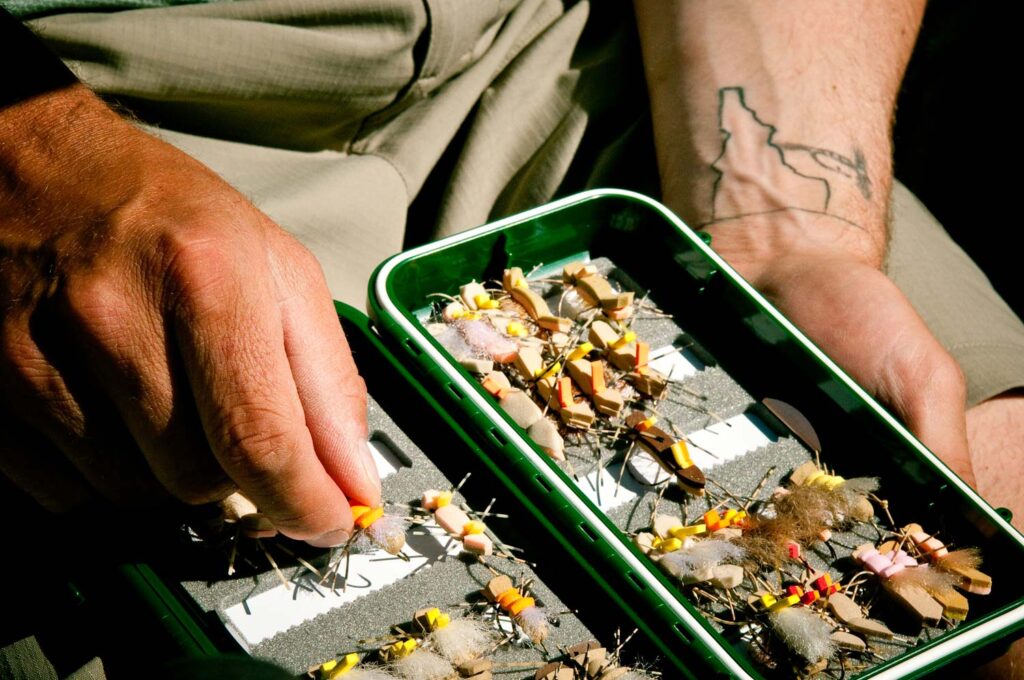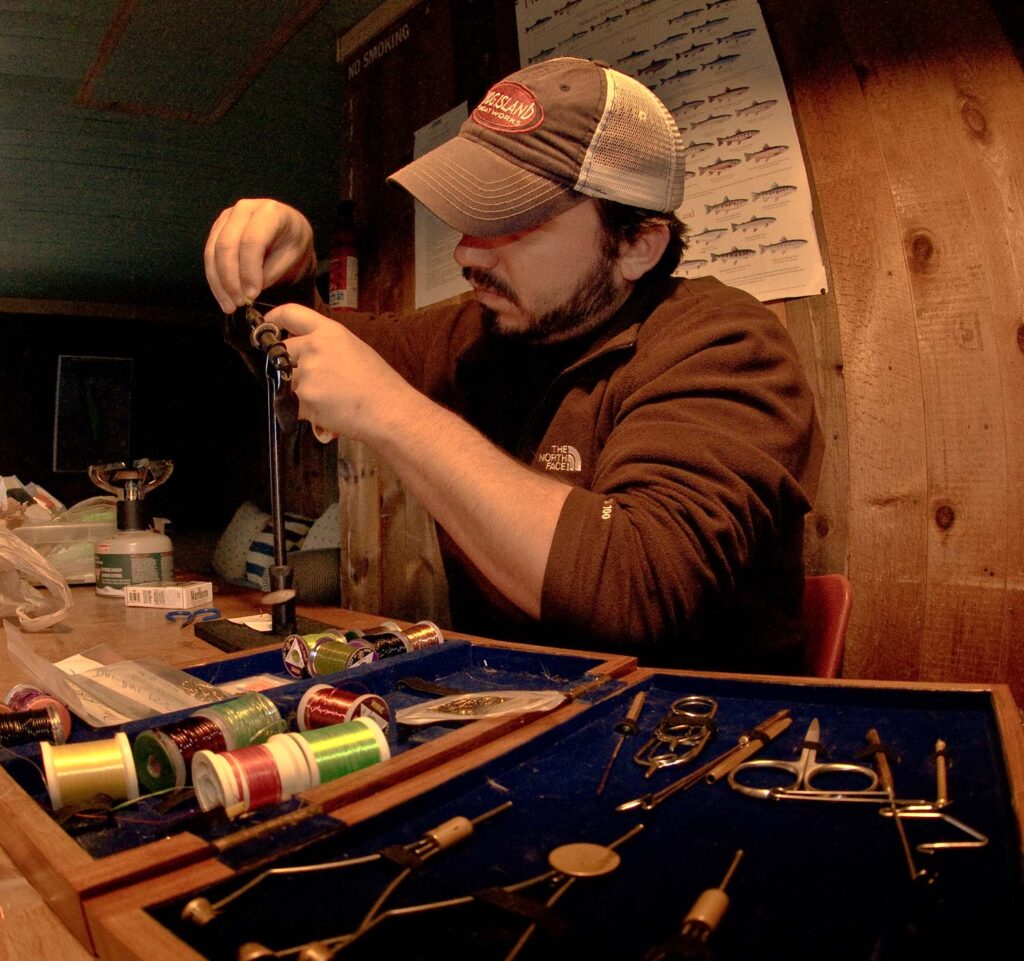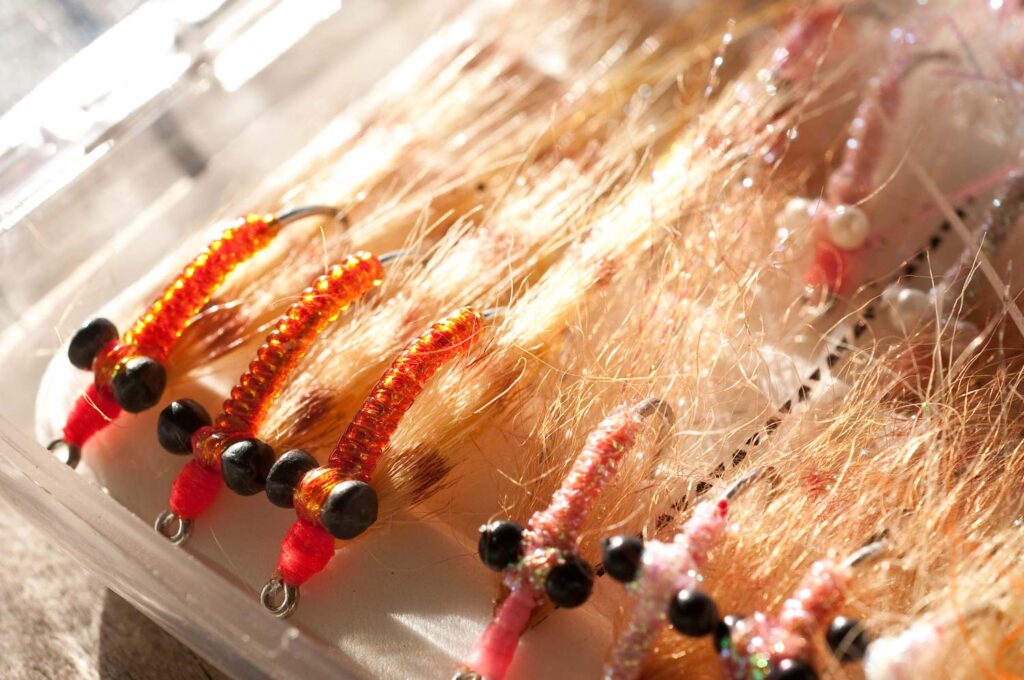
By Jason Tucker
This is a question that pops up every week wherever social media may be found and a lot of times the answer you get is “NO!”
But it’s not that simple so I’m going to offer you some pros, cons and tips including cautionary nuggets from my own experience. I would encourage most fly anglers to get into fly tying with some caveats.
If you’re getting into fly fishing you may have noticed the price of flies- around $2 a pop for even a simple egg pattern, and quickly climbing. Most well-tied dries will run $3-$5 and those beautiful big pike and muskie patterns can run up to $24 a fly, with most trout streamers costing $6-$8. This means a dozen flies can cost you $30-$50 and a bad day on the water can get expensive fast.
We’ve all run into that guy on the river with multiple fly boxes stuffed full of beautiful flies he tied himself, handing them out like candy, and when you protest or offer to pay he says what I say- “It costs me almost nothing to tie these.”
And he’s right, almost.
So right off the bat I’m going to tell you who should not tie their own flies (and why not). If you are a casual fly angler who fishes a dozen times a year and has a good local fly shop, I’d say fly tying is a poor investment. You will probably spend about $400 dollars to start fly tying if you’re doing it right, and if you have good impulse control. You can buy a lot of flies for $400.
Other reasons to not get into fly tying- not having a place to do it or to store materials, or having a family or work situation that doesn’t afford the time to give it the attention it requires. Pets can also be a factor, dogs especially- a dog can chew its way through hundreds of dollars in materials in a short time if left unattended, and dropped hooks or lost flies are very dangerous to pets.
If you have visions of fly tying riches, you should probably not do it. Fly tying is a fun hobby, but trying to make money at it is a different story- if you have seasonal work and endless patience doing long hours of tedious work that will strain your eyes and hands, fine, but it can be really depressing when you figure out how many flies you need to crank out per hour just to make twenty bucks an hour, which these days isn’t exactly killing it. There is a definite and probably low upper limit to what you can actually make tying flies. There is also a learning curve and consistency is a factor- I use almost exclusively my own flies and catch plenty of fish, but my flies are not tied consistently or professional looking enough to actually sell to a fly shop.
If you exclusively fish dry flies, fly tying may not be for you. I confess I am not skilled at all at tying dries, and for all the money I would have to spend to get the right hackle and materials vs. the number of dry flies I lose each year, I can just keep buying dries. Because I already own a vise I’m slowly adding to my repertoire of dry flies I tie, but I would never jump into it to tie dries due to the cost of good hackle and the learning curve. I would say you’re better off learning to tie other easier flies first and slowly add dries to the mix as you learn the basics and get a feel for how to proportion flies properly. In dry flies proportion is one of the most difficult aspects to master, and one of the most important.
If you have poor impulse control (like I do) then you will probably spend more on materials than you’ll ever save tying. Once you start tying and get the itch, every visit to the fly shop is a hazard- you see all those beautiful materials hanging on the wall, you think of some crazy fly you can make, and materials are only five, six bucks a package. Within months you’ve bought $600 in tying materials and tied $100 in flies.
Who should get into fly tying? Avid fly anglers who fish a lot and go through a lot of flies should, especially if the cost of flies is impacting your time on the water. Yes there is an upfront investment, but if you do it right and are smart about your materials purchases you can probably at least break even your first year. If you’re fishing a lot of eggs and simple patterns for steelhead and salmon (I’m not talking about Spey and Skagit style flies) like in the Great Lakes, if you fish a lot of nymph patterns, or have gotten the streamer bug bad, you can definitely save money over time by tying your own flies.
So here’s how to get into fly tying, at worst break even, and at best save a lot of money.
Buy a good vise. You can buy a vise for around $100 or even less, but $200 buys you a good basic rotary vise. A cheap vise could get you by, but it can also be frustrating to use, and if you get frustrated and don’t use it that money is wasted. You also don’t need to spend $700 for a vise with all the bells and whistles- a rotary vise from a good brand like Renzetti, Peak (my choice) or Dyna-King will get you where you need to go.
Next, get some decent tools. You’ll want a couple bobbins, some threaders, a dubbing brush, a whip finisher, GOOD scissors (which you can find at a fabric store to save a couple bucks), etc.
Only buy the materials you absolutely need. The key to saving money starting out is as follows- you fish enough that you lose a lot of flies, and buying flies is a limiting factor on your fishing. Once you’ve made the upfront investment in a vise and tools, only buy the specific materials you need to tie the flies you are using and losing. It is too easy to go hog wild on materials and end up with hundreds of dollars of materials sitting around unused.
For me fly tying became worth the investment when I got into fishing for Great Lakes steelhead and salmon. I was going through egg patterns and woolly bugger variations like crazy, some to fish and some to the cedar choked rivers I fished. The only way to sustain the habit was to buy a vise. I spent about $250 on a vise and tools, then spent the winter tying eggs and other Great Lakes steelhead flies, limited my purchases to the hooks, yarn and thread I actually needed, and possibly broke even my first year.
I’ll pause for a moment here to advocate egg patterns as the first flies you should concentrate on. Why? They’re quick to tie, the materials are cheap, and fish eat them. You will learn valuable lessons quick, like starting thread on a hook, getting proportions right, and whip finishing. You can easily razor all the ugly ties off your hooks and start over.
Once you have the basic skills down- getting a hook into your vise at the right angle and pressure, starting your thread, proportioning your fly, and whip finishing, you’re ready to move on to simple nymphs like pheasant tails. Again, buy just the hooks, thread and materials you need for this pattern, then build on the skills you already have, getting the proportions and the look right. From there you can move on to hare’s ears, prince nymphs, RS2’s etc. With each pattern buy exactly what you need and go from there.
Woolly buggers are a next logical step. Now you’re learning skills like palmering, proportioning a tail, and proportioning material on a longer hook. It’s an old but still effective pattern that catches fish in almost any body of water, even salt.
The next obvious step is streamers. You can start simple with black nosed dace and Mickey Finns which are cheap, simple patterns to tie that still catch lots of fish. From there you can work your way into tying the modern streamers that are extremely effective and expensive to buy. If you’re going to get into muskie or pike fishing, tying your own streamers is the way to go. Again, restraint in buying materials is key.
Bonefish flies are one category where I have definitely saved a lot of money tying my own. You may only use a dozen or fewer flies in a week of bonefishing, but most of the locations you go to will be remote and probably not have a fly shop, or the resort you’re staying at will have a limited selection for nosebleed prices. You will want to bring a couple hundred flies in a variety of sizes, patterns and colors to cover your bases. You can spend hundreds on commercially tied flies, or tie your own for $50-$60 in materials. I’ve been on multiple bonefish trips now, and to my recollection have caught all my bonefish on my own flies (including a thirteen pounder) with a $60 investment in materials, and still have enough left over to tie a couple hundred more flies.
I’ll offer one last scenario in which it is worth it to tie your own flies- if you have a considerable off-season but want to stay connected to the sport, fly tying is a great way to do this. If you are judicious with your material purchases and stick to patterns you use it won’t bruise your pocketbook too badly. Fly shops, sportsmen’s clubs and even local breweries often host fly tying nights throughout the winter and it’s a great way to connect with other anglers, talk fishing, learn new skills and patterns, and fill fly boxes while you’re at it.
Over time you can and will find yourself with the materials and skills to tie your own dry flies even, and with all these flies, there is nothing more satisfying than catching all your fish on flies you’ve tied. Pretty soon you’ll be the guy at the access handing out fistfuls of flies to new guys saying “Don’t worry about it, it costs me almost nothing to tie these.”
Justin Pickett
Gink & Gasoline
hookups@ginkandgasoline.com


